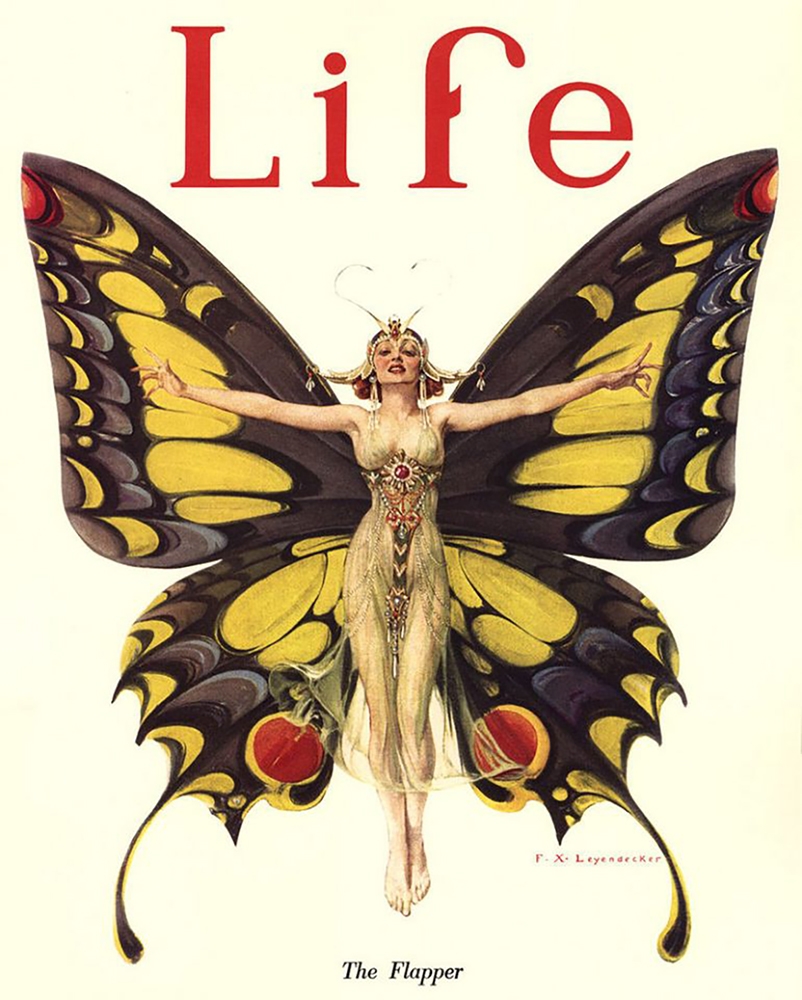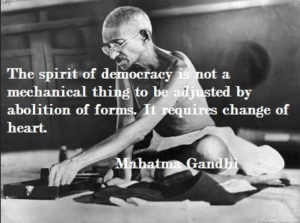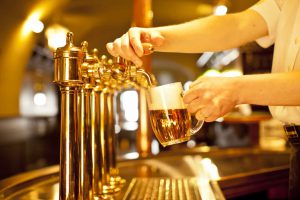Winner of the Fall 2016 StMU History Media Award for
Best Article in the Category of “Culture”
When one thinks of the 1920’s era one immediately thinks about Flappers. A flapper was considered a young woman who was very fashionable. This was a young female who enjoyed life to the fullest, flouting her unconventional standards of behavior and carefree party lifestyle.1 The spirit behind this movement was all about leaving the traditional ways of life behind and transforming into an independent woman.

Before World War I, the concept of femininity was referred to as the Gibson Girl. This term was used to describe these new independent and often well educated women. Gibson girls wore their hair long, pinned up and adorned with beautiful hats. They completed their ensemble by wearing long skirts and blouses that buttoned up to their necks. Despite their feminine appearance, these women were more than capable of doing the same things that men did. Examples of this include activities such as playing sports: skating, golfing, bicycling, tennis. These young ladies did not go out until they were asked properly by a young man who had good intentions and a promise of marrying them. Gibson Girls soon broke away from their traditional ways.2
In 1915, two years before America’s entry into World War I, a famous author by the name of H.L. Mencken introduced the word “Flapper” to the United States. Mencken stated that a flapper was “a woman who consumed music, literature and periodicals voraciously taking her cues for behavior and style from the media in front of her rather than the moral codes of decorum.”3 Another famous author, F. Scott Fitzgerald, famous for his classic novel The Great Gatsby, described the flapper as “lovely, expensive, and about nineteen.” John Held Jr., who was an American cartoonist, emphasized the flapper by drawing young girls wearing unbuckled galoshes that would make a “flapping” noise when walking.4 Despite the many different terms, Flappers were described essentially the same way: they were young girls who enjoyed the party life and had a sense of fashion.
After World War I ended in 1918, many things had changed for the men returning home, particularly the roles and values that women were embracing. The traditional values were gone and in their place came a faster, sleeker, and more daring approach to life. This time period not only ushered in an era of change in values, but it also established a new baseline for what was considered feminine. The Flapper Age was born and it brought with it a new and independent woman. These women smoked, drank, voted, cut their hair into bobs, wore eyeliner, and went to as many parties as they could—enjoying every bit of the social life along the way.5

During the 1920’s, fashion changed drastically due to a very famous designer, Coco Chanel. This woman helped flapper fashion to stand on its own. Typical flapper clothing included a simple sack like dress, which allowed women of all classes to make their own dresses and remain on trend.6 The waist of the dress was dropped to the hipline, and the skirt fell just below the knee. Stockings made of rayon were added and worn over a garter belt. To complete the look, bracelets were added and necklaces ran from the neck to the waist. Cloche hats sat atop their heads and drew the eye into a new hairstyle trend known as the bob.7 The make-up of flappers consisted of a red powder or cream that was used for the lips and cheek, eye-liner, powder for the face, and red lipstick that became very popular.
On January 19, 1919, the Eighteenth Amendment, also known as the Volstead Act, came into effect and gave way to the Prohibition Era in which the sale, production, importation, and transportation of alcohol was banned across the nation.8 This change in the legal system caused the sale and consumption of liquor and alcohol to go underground. The most rebellious thing a flapper could do at this time was to consume alcohol, and these young girls had a reputation for being giddy. The following year, on August 18, 1920, the Nineteenth Amendment was passed and women now had the right to vote.9 In 1924, the first radio launched more than 600 commercial channels around the U.S. The radio at the time was the social media on the flapper life. Many young girls swarmed the theaters to see the image of the flapper on screen. Famous actress Clara Bow, starred in the “Flapper” and made the look iconic.
On December 2, 1927, Henry Ford invented the Model A vehicle and car sales increased.10 Women were now owners of vehicles, and the car became a lifeline to a world full of excitement for the flapper in particular. With no one to stop them, they were free to come and go as they pleased. Liberated women were now able to go out and enjoy dancing during this era that was the Jazz Age. The most popular thing for a flapper to do was to go to a nightclub where she would drink, dance, and show off her moves. The era of the Flapper, however, came to an end with the Wall Street Crash of 1929. Many young women lost their jobs and the incomes that had given them such independence.11
Life in the 1920’s left a huge legacy for women to this day. Flappers and the forward-thinking concept of the modern woman is what initiated the change in society for how women were viewed then as well as how they continue to be viewed in present day. With their bold choice in attire, along with their new views and attitudes regarding femininity, both in fashion as well as social conduct, Flappers left behind the old traditional ways and paved the road for a more liberated female.
- Salem Press Biographical Encyclopedia, January 2016, s.v. “Flappers,” by R.L. Smith. ↵
- Kelly B. Sagert, Flappers: A Guide to an American Subculture (Greenwood Publishing Group, 2010), 1-2. ↵
- Brian DiPaolo, Flappers: Issues & Controversies in American History (Infobase Publishing, 2007), 4-5. ↵
- DiPaolo, Flappers: Issues & Controversies in American History, 4-5. ↵
- Soo Hyun Park, Flapper Fashion In the Context of Cultural Changes of America in the 1920’s (CUNY Academic Works, 2014), 1-2. ↵
- Salem Press Biographical Encyclopedia, January, 2016, s.v. “Flappers,” by R.L. Smith. ↵
- Sagert, Flappers: A Guide to an American Subculture, 3. ↵
- Sagert, Flappers: A Guide to an American Subculture, 5. ↵
- DiPaolo, Flappers: Issues & Controversies in American History, 2. ↵
- F.L. Allen, Only Yesterday: An Informal History of the Nineteen Twenties (National Humanities Center, 1931), 5. ↵
- Alan Brinkley, American History: Connecting with the Past Volume 2, 15 edition (New York: McGraw-Hill Education, 2014), 643. ↵




213 comments
Anayeli Prieto
After reading this article I noticed that one character in particular, Jordan Baker, who is a professional golfer, has that characteristic that is described in the article. in the roaring twenties, men were the ones who were the most athletic and fact that this woman was a professional golfer, demonstrates how she as a woman can complete the same tasks as men. she also has this very intense and mysterious personality which isi completely different to daisy’s who is more feminine and motherly as well as romantic and cheerful.
Aimee Trevino
Really interesting article! I became really interested in the “Flapper” lifestyle after reading The Great Gatsby in high school, but never really had all this detail and information. I really liked how you started off with the image and explanation of the Gibson Girls to truly explain how the Flapper was really a rebellious type of lifestyle, and paved the way for a more liberal woman. Loved it!
Aaron Jaramillo
Awesome article about the roaring 20’s. You gave great detail to describe these young ladies. I have always heard of Flappers and associated them with this era but I had never heard of Gibson Girls. Amazing how the Flappers paved the way for many young women that have followed them both in fashion and socially.
Jacob Hall
The flappers were amazing, in fact their one of my favorite parts of the 1920’s.
From fashion, to parties, to being the independent girls the flappers were perhaps one of the most rebellious groups of the 1920’s. Every aspect of them stood for female independence, and they sought to rebel against the norms of male dominated society. Thus the reason for them being depicted as the bad girls of the time, and I think your article does a great job of telling their story.
Maalik Stansbury
Who knew that flappers had such a fashion sense. That is pretty cool how they expressed themselves in an artistic way and manner. But from reading the article it makes you think what type of treatment did they receive for being flappers, but sometimes you got to do things in order to be yourself.
Erik Rodriguez
Awesome article! Flappers truly paved the way for modern day women. I cannot believe ladies were not allowed to play sports or leave the house without a man. I am sure many of the strong women in my life could never live by these terms. I am grateful for the flappers who started gender equality.
Overall, this article taught me how much of an impact flappers had.
Very eye opening and fascinating!
Keep up the good work!
Carmen Alonz
The article was well written and informative….the only thing I would have added to the conclusion would be how the evolution of the Flapper has affected you as a women. Good job!
Lucia
Love the article makes me want to go back in time to the flapper era!!
Johnny Escobedo
As I read this article it confirmed my belief that everyone is different in their own unique way. Flappers led a great movement which I knew nothing about. Some women choose to be independent while others choose to be interdependent. I think either way or a mixture of both is great. I see from this article that everyone should pursue what makes them happy without being looked at differently. Anyhow this was a great read and very enlightening. Very good job!!!
shannon
I really believe this article will/does resinate with our generation of women. Being different or untraditional isn’t necessarily a bad thing, it can change our world. It can change our outlook, fashion, and acceptance within each other.